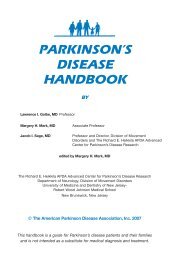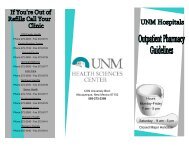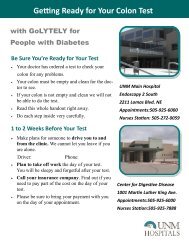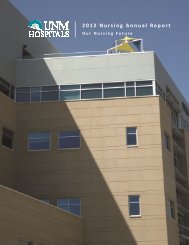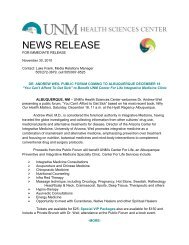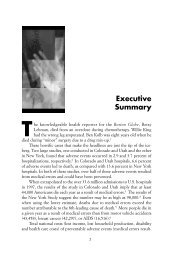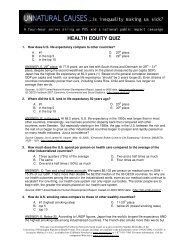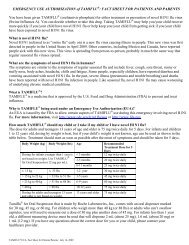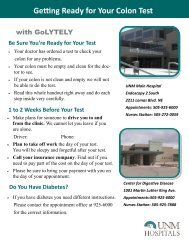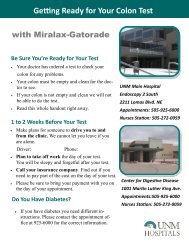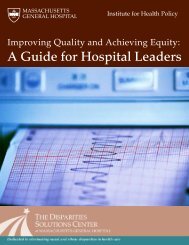Advanced Effective Communication, Cultural Competence, and ...
Advanced Effective Communication, Cultural Competence, and ...
Advanced Effective Communication, Cultural Competence, and ...
Create successful ePaper yourself
Turn your PDF publications into a flip-book with our unique Google optimized e-Paper software.
A Roadmap for Hospitals<br />
Appendix B: Current Joint Commission Requirements<br />
Joint Commission LD Requirements<br />
LD.02.01.01 The mission, vision, <strong>and</strong> goals of<br />
the hospital support the safety <strong>and</strong> quality of<br />
care, treatment, <strong>and</strong> services.<br />
Rationale for LD.02.01.01<br />
The primary responsibility of leaders is to provide for the safety<br />
<strong>and</strong> quality of care, treatment, <strong>and</strong> services. The purpose of the<br />
hospital’s mission, vision, <strong>and</strong> goals, is to define how the<br />
hospital will achieve safety <strong>and</strong> quality. The leaders are more<br />
likely to be aligned with the mission, vision, <strong>and</strong> goals when<br />
they create them together. The common purpose of the<br />
hospital is most likely achieved when it is understood by all who<br />
work in or are served by the hospital.<br />
EP 3 Leaders communicate the mission, vision, <strong>and</strong> goals to<br />
staff <strong>and</strong> the population(s) the hospital serves.<br />
LD.03.02.01 The hospital uses data <strong>and</strong><br />
information to guide decisions <strong>and</strong> to<br />
underst<strong>and</strong> variation in the performance of<br />
processes supporting safety <strong>and</strong> quality.<br />
Rationale for LD.03.02.01<br />
Data help hospitals make the right decisions. When decisions<br />
are supported by data, hospitals are more likely to move in<br />
directions that help them achieve their goals. Successful<br />
hospitals measure <strong>and</strong> analyze their performance. When data<br />
are analyzed <strong>and</strong> turned into information, this process helps<br />
hospitals see patterns <strong>and</strong> trends <strong>and</strong> underst<strong>and</strong> the reasons<br />
for their performance. Many types of data are used to evaluate<br />
performance, including data on outcomes of care, performance<br />
on safety <strong>and</strong> quality initiatives, patient satisfaction, process<br />
variation, <strong>and</strong> staff perceptions.<br />
EP 3 The hospital uses processes to support systematic data<br />
<strong>and</strong> information use.<br />
EP 5 The hospital uses data <strong>and</strong> information in decisionmaking<br />
that supports the safety <strong>and</strong> quality of care,<br />
treatment, <strong>and</strong> services.<br />
EP 3 <strong>Communication</strong> is designed to meet the needs of<br />
internal <strong>and</strong> external users.<br />
EP 5 <strong>Communication</strong> supports safety <strong>and</strong> quality throughout<br />
the hospital.<br />
EP 6 When changes in the environment occur, the hospital<br />
communicates those changes effectively.<br />
LD.04.01.01 The hospital complies with law <strong>and</strong><br />
regulation.<br />
EP 2 The hospital provides care, treatment, <strong>and</strong> services in<br />
accordance with licensure requirements, laws, <strong>and</strong> rules<br />
<strong>and</strong> regulations.<br />
LD.04.03.07 Patients with comparable needs<br />
receive the same st<strong>and</strong>ard of care, treatment, <strong>and</strong><br />
services throughout the hospital.<br />
Rationale for LD.04.03.07<br />
Comparable st<strong>and</strong>ards of care means that the hospital can<br />
provide the services that patients need within established time<br />
frames <strong>and</strong> that those providing care, treatment, <strong>and</strong> services<br />
have the required competence. Hospitals may provide different<br />
services to patients with similar needs as long as the patient’s<br />
outcome is not affected. For example, some patients may<br />
receive equipment with enhanced features because of<br />
insurance situations. This does not ordinarily lead to different<br />
outcomes. Different settings, processes, or payment sources<br />
should not result in different st<strong>and</strong>ards of care.<br />
EP 1 Variances in staff, setting, or payment source do not<br />
affect outcomes of care, treatment, <strong>and</strong> services in a<br />
negative way.<br />
EP 2 Care, treatment, <strong>and</strong> services are consistent with the<br />
hospital’s mission, vision, <strong>and</strong> goals.<br />
LD.03.04.01 The hospital communicates<br />
information related to safety <strong>and</strong> quality to<br />
those who need it, including staff, licensed<br />
independent practitioners, patients, families,<br />
<strong>and</strong> external interested parties.<br />
Rationale for LD.03.04.01<br />
<strong>Effective</strong> communication is essential among individuals <strong>and</strong><br />
groups within the hospital, <strong>and</strong> between the hospital <strong>and</strong><br />
external parties. Poor communication often contributes to<br />
adverse events <strong>and</strong> can compromise safety <strong>and</strong> quality of care,<br />
treatment, <strong>and</strong> services. <strong>Effective</strong> communication is timely,<br />
accurate, <strong>and</strong> usable by the audience.<br />
EP 1 <strong>Communication</strong> processes foster the safety of the<br />
patient <strong>and</strong> the quality of care.<br />
52



